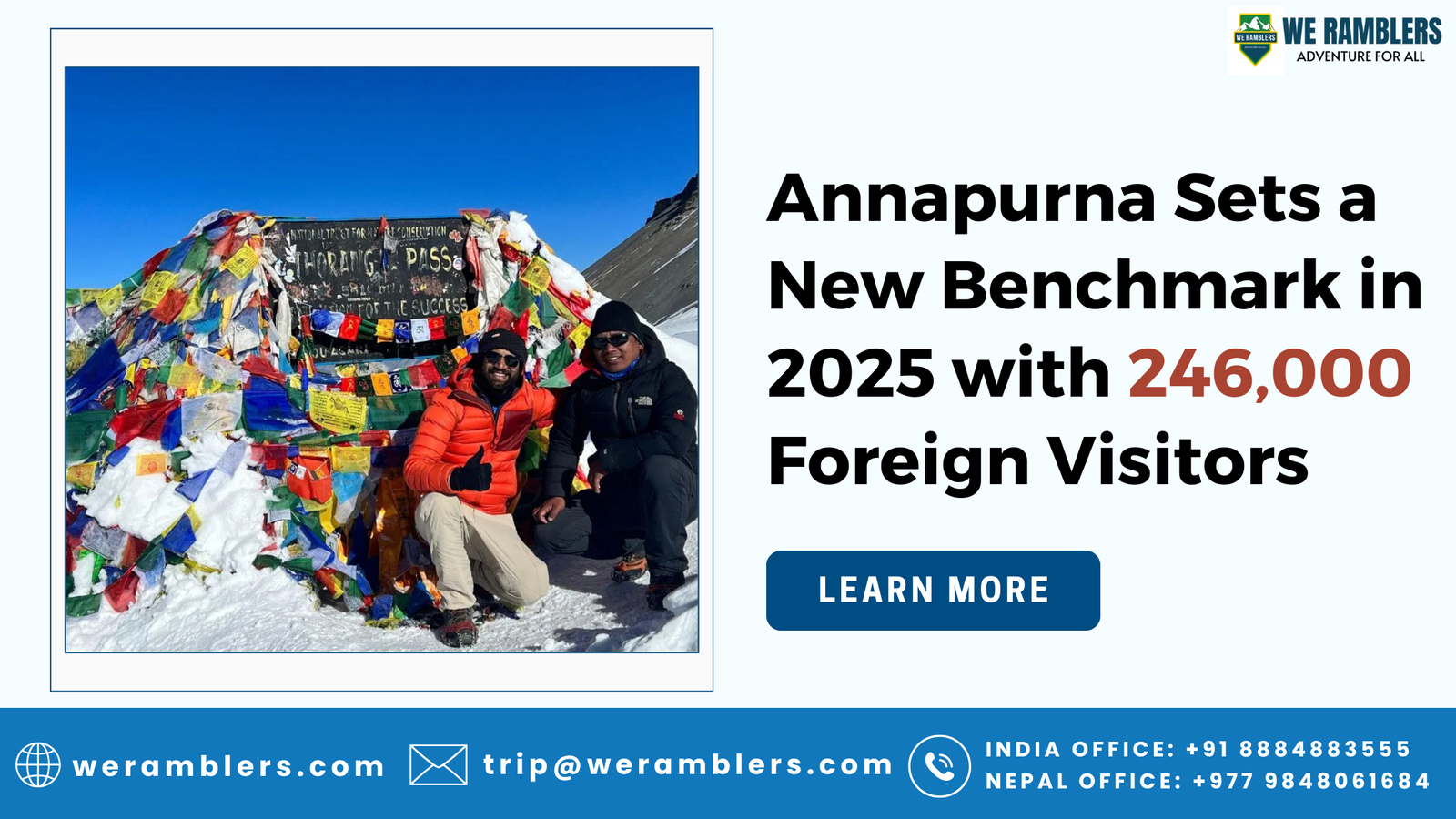Nepal’s Annapurna Region Sees Record Tourist Arrivals in First Ten Months of 2025
The Annapurna region, one of Nepal’s most beloved trekking areas, has once again proven its global appeal. According to the Annapurna Conservation Area Project (ACAP), a record-breaking 246,575 foreign tourists visited the region between January and October 2025, marking a significant milestone for Nepal’s tourism revival and setting a new benchmark for sustainable mountain tourism in South Asia.
This surge in visitors reflects not just the enduring allure of the Annapurna Circuit Trek, Annapurna Base Camp (ABC), and Muktinath region, but also the region’s growing accessibility, improved infrastructure, and renewed traveler confidence after the pandemic years.
Record Numbers in 2025: Annapurna’s Tourism Boom
Data from ACAP reveal that out of 246,575 foreign trekkers,
- 146,968 came from South Asian countries, and
- 99,607 arrived from the rest of the world.
This balance shows that while Annapurna continues to captivate international trekkers, the region is also becoming increasingly popular among South Asian travelers seeking spiritual, cultural, and adventure experiences close to home.
What’s even more impressive is that the total number of foreign visitors in 2024 stood at 244,045, a number that Annapurna has already surpassed within the first ten months of 2025. With November and December traditionally strong months for trekking, the final figure for 2025 is expected to climb even higher.
When Did Most Tourists Visit? Seasonal Trends and Insights
April saw the highest influx of trekkers with 44,763 arrivals, coinciding with spring, when rhododendrons are in bloom, skies are clear, and high passes are comfortably navigable. On the other hand, January recorded the lowest figure at 9,359 visitors, reflecting the challenges of winter trekking in high-altitude zones.
ACAP Chief Dr. Rabin Kadariya noted that tourist arrivals increased across nearly all months of 2025 compared to 2024, except in May and September. This steady growth underscores the region’s resilience and popularity, even amidst changing global travel trends.
The peak seasons of March–May (spring) and September–November (autumn) continue to draw the majority of trekkers, and 2025 was no exception. These months offer the most stable weather, clearest mountain views, and best trail conditions across the Annapurna range.
A Post-Pandemic Comeback Story
The growth story becomes even more striking when viewed through the lens of the pandemic years.
In 2020, only 18,836 foreign tourists entered the Annapurna Conservation Area, a historic low, brought about by COVID-19 lockdowns and travel restrictions. But by 2023, the number rebounded to 191,666, and now, in 2025, the region has exceeded 246,000, signaling a full recovery and a strong rebound in adventure tourism.
This remarkable comeback highlights the global trust in Nepal as a safe and rewarding trekking destination. It also reflects the successful collaboration among local communities, conservation authorities, trekking agencies, and international partners to restore tourism sustainably.
Why Annapurna Remains a Global Favorite
1. The Legendary Annapurna Circuit Trek
The Annapurna Circuit continues to be one of the most sought-after treks in the world. Stretching through lush subtropical forests, alpine meadows, and high mountain passes like Thorong La (5,416 m), it offers a complete Himalayan experience, combining cultural diversity, spectacular landscapes, and spiritual serenity.
Trekkers can walk through traditional Gurung and Thakali villages, visit Muktinath Temple, and enjoy panoramic views of Annapurna I, Dhaulagiri, Machhapuchhre, and Manaslu, all within a single journey.
2. Annapurna Base Camp (ABC) Trek
For those with limited time, the Annapurna Base Camp Trek offers a shorter yet equally stunning experience. The trail leads trekkers through terraced fields, rhododendron forests, and traditional villages to the heart of the Annapurna Sanctuary, surrounded by towering peaks on all sides.
3. Muktinath and Jomsom: The Pilgrimage Connection
The Muktinath area, accessible via both trekking and surface routes, continues to see a high number of pilgrims and trekkers. Revered by both Hindus and Buddhists, Muktinath combines natural beauty with deep spiritual meaning, making it a unique addition to the Annapurna experience.
4. Accessibility and Infrastructure
Improved road connectivity, domestic flights from Pokhara to Jomsom, and better-managed trails have all contributed to Annapurna’s rising visitor numbers. Many trekkers now opt for shorter segments or mix of road-and-walk itineraries, allowing more flexible travel options.
Sustainable Tourism: Balancing Growth and Conservation
While the rising tourist numbers bring economic opportunities for local communities, they also underscore the need for sustainable tourism management. The Annapurna Conservation Area Project (ACAP), established in 1986, remains a global model for community-based conservation.
The project has played a crucial role in:
- Promoting eco-friendly trekking practices
- Managing waste and preserving biodiversity
- Empowering local communities through tourism income
- Encouraging the use of alternative energy and sustainable lodges
With more than 246,000 foreign visitors recorded this year, ACAP’s continued focus on responsible tourism is vital to protect Annapurna’s fragile ecosystems and cultural heritage.
Local Communities Reap the Benefits
The Annapurna region is home to thousands of families who rely on tourism for their livelihood, from teahouse owners and guides to porters and craft sellers. The 2025 tourism boom has brought economic stability to these mountain communities, especially after the slow years of the pandemic.
In villages like Manang, Ghandruk, Chame, and Ghorepani, the influx of trekkers has revitalized local businesses, improved infrastructure, and supported education and conservation initiatives. The positive ripple effects of tourism extend beyond the trekking routes, reaching schools, women’s cooperatives, and community development projects.
Challenges Ahead: Infrastructure, Waste, and Climate Change
While the upward trend is promising, Annapurna also faces challenges that come with mass tourism:
- Waste management remains a pressing concern on popular routes.
- Climate change is altering weather patterns, glacier behavior, and water availability.
- Unplanned road construction has changed some traditional trekking trails.
To sustain growth responsibly, continued investment in infrastructure, local training, and environmental awareness programs will be essential.
The Road (and Trail) Ahead: What’s Next for Annapurna Tourism?
With the 2025 trekking season still ongoing, experts expect total visitor numbers to surpass 270,000 by year’s end. This milestone would mark the highest annual foreign tourist arrival in Annapurna’s history.
Looking ahead, the region is set to benefit from:
- Digital permit systems simplifying entry formalities
- Improved road networks reducing travel time between key points
- New trekking routes and homestay programs promoting rural inclusivity
- Increased international marketing of lesser-known treks like Mardi Himal, Khopra Ridge, and Nar-Phu Valley
Nepal’s Tourism Board and private operators like We Ramblers are already playing an active role in shaping this new era of adventure tourism, one that values authenticity, sustainability, and community connection.
What Makes Annapurna Special for Trekkers
Whether you are a first-time trekker or a seasoned mountaineer, Annapurna offers something for everyone:
- Stunning mountain panoramas of some of the world’s highest peaks
- Rich cultural encounters with Gurung, Thakali, and Tibetan-influenced communities
- Diverse trails ranging from easy village walks to challenging high passes
- Comfortable lodges and teahouses offering warm hospitality
- Safe and well-managed trekking infrastructure
These factors make Annapurna not just a trekking destination, but a transformative experience for travelers from all walks of life.
Travel with We Ramblers: Your Trusted Annapurna Trek Partner
At We Ramblers, we believe trekking in the Annapurna region is not just about reaching the destination, it’s about the journey, the people you meet, and the stories you collect along the way.
With expert local guides, well-planned itineraries, and a deep commitment to safety and sustainability, We Ramblers ensures every trekker enjoys a seamless and meaningful Himalayan adventure.
Whether you’re dreaming of the Annapurna Circuit Trek, Annapurna Base Camp Trek, or short scenic trails around Pokhara, we handle every detail, from permits and logistics to transport and accommodation.
Why Choose We Ramblers?
- Experienced & insured local trekking teams
- Authentic cultural experiences
- Eco-friendly and responsible travel practices
- Transparent pricing and small-group departures
- Personalized support before and during your trek
Join We Ramblers in celebrating the Annapurna region’s incredible achievement, and be part of its next chapter in 2026.
Plan Your Annapurna Adventure Today
The mountains are calling, and the trails of Annapurna are more vibrant than ever. Book your Annapurna trek with We Ramblers for the upcoming 2026 season and experience Nepal’s most iconic trekking region at its best.





